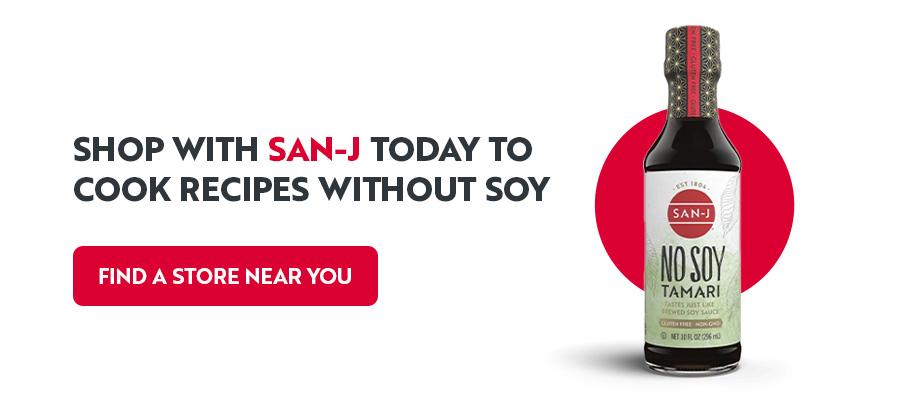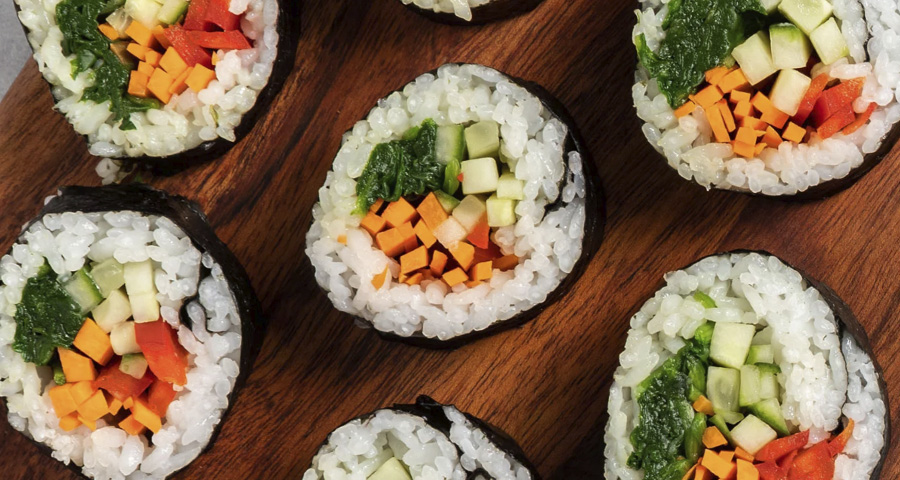Although foods containing soy or soy products are incredibly common, some people avoid soy due to allergies or other dietary restrictions. If that describes you, you already know that eating soy-free doesn’t mean giving up on taste — there are tons of tasty soy-free recipes and alternatives out there!
Learn more about soy-free diets and how to cook three of the best soy-free recipes.
- Salmon Sushi Cups
- Vegetable Kimbap with Spicy Tamari
- Bok Choy and Wild Mushroom Soba Noodle Stir-Fry
Why People Avoid Soy
Soy-free diets are common worldwide for a variety of reasons, such as allergies and dietary restrictions. Here are some of the biggest reasons people avoid soy.
Allergies
Soy allergies are common around the world, often occurring in infants and young children. In fact, 0.4% of infants in the United States have some form of soy allergy. While many individuals outgrow a soy allergy, others maintain it throughout their lives.
Those with soy allergies have various reactions to it, such as hives, coughing or itching. Avoiding soy-rich foods like tofu, edamame and tempeh, as well as sauces or condiments like soy sauce, is the best way to prevent a reaction. Fortunately, soy-free options exist to help those with allergies maintain a healthy diet while enjoying delicious foods.
Dietary Restrictions
Individuals might also remove soy from their diet because of various health concerns or preferences. Certain soy products contain high levels of estrogen chemicals, which can impact reproductive health in high enough doses. That’s why some medical professionals recommend a soy-free diet for patients who need help regulating their estrogen levels.
Others might seek a diet without soy due to personal choice. They could dislike the taste of soy products and opt for soy-free dishes to meet these preferences.
3 Delicious Soy-Free Recipes
Recipes with soy-free ingredients help accommodate soy allergies and dietary restrictions or preferences. If you follow a soy-free diet or are looking to introduce more soy-free recipes into your diet, we have some ideas! These are a few of the best recipes without soy to make at home:
1. Salmon Sushi Cups
Hosting a party with guests who don’t eat soy? Try this unique spin on classic sushi for a fun finger food everyone will love!
Start with these ingredients:
- 3 nori sheets
- ¾ pound of salmon filet
- 2 tablespoons of mayonnaise
- 1-2 teaspoons of sriracha sauce
- ¼ cup and 1 teaspoon of SAN-J No Soy Tamari, divided
- 1 and ½ cups of cooked sushi rice
- ¼ cup rice vinegar
- 2 teaspoons of sesame oil
- 2 green onions, finely chopped
- ¼ teaspoon of red pepper flakes
- ½ avocado, diced
- Sesame seeds
Once you have the ingredients ready, preheat the oven to 400 degrees Fahrenheit. Next, slice 3 nori sheets into quarters until you’re left with 12 squares. Slice the salmon into ½-inch diced squares and place in a large bowl. Add the mayo, 1-2 teaspoons of sriracha and 1 teaspoon of No Soy Tamari to the bowl, and mix to combine.
Grab a mini-muffin tin out of your cupboard, and line it with the nori squares. Place 1 tablespoon of rice and a spoonful of the salmon mixture into each nori square. Repeat this step until you use the entire salmon and mayo mixture. Then, bake for 13-15 minutes until golden brown.
While the sushi cups are cooking, mix ¼ cup of No Soy Tamari with ¼ teaspoon of red pepper flakes, ¼ cup vinegar and 2 teaspoons of sesame oil. Use this mixture as a dipping sauce or drizzle it over the top of your sushi cups once they’re done cooking.
2. Vegetable Kimbap With Spicy Tamari
Kimbap is a Korean dish made with cooked rice, meat and vegetables rolled in dried seaweed sheets. Its delicious and fresh taste makes it a favorite for appetizers or meals around the world.
You can make a vegetarian version with these ingredients:
- 1 teaspoon of olive oil
- 1 bag of spinach
- 1 teaspoon of kosher salt
- Sesame oil for seasoning
- 3 cups of cooked sushi rice
- 2 medium carrots
- 1 English cucumber
- 2 medium red bell peppers
- 6 sheets of nori
- ½ cup of SAN-J No Soy Tamari
- 2 teaspoons of Korean chili flakes
Heat olive oil in a large skillet over medium heat. Add 1 bag of spinach, cooking for 2-3 minutes until it wilts slightly. You can also add some salt to the skillet for enhanced flavor.
Place 3 cups of cooked sushi rice in a large bowl, and season it with salt and sesame oil. Next, set a rolling mat on a flat surface. Place one of the nori sheets on the mat, and spread a bit of rice over the top, leaving a 1-inch border. On top of the rice in the middle of the sheet, add 2 tablespoons of spinach, a few sliced carrots, some cucumbers and some bell peppers.
Roll the mat up and away from you, using your fingers to keep the veggies secure as you go. Then, pull the mat forward, and roll the nori and rice around the filling. Keep rolling until the roll seals, and brush the roll with sesame oil. Slice the roll into 6 pieces with a sharp knife. Repeat these steps until you use up the remaining vegetables, nori and rice.
To create a delicious dipping sauce, mix the No Soy Tamari with the chili flakes. You can also pour it over the kimbap. Enjoy!
3. Bok Choy and Wild Mushroom Soba Noodle Stir-Fry
This delicious stir-fry is a quick and easy dish perfect for a weeknight dinner. Use gluten-free soba if needed.
Here’s what you’ll need:
- 16 ounces of soba noodles
- 1 tablespoon rice wine vinegar
- 2 teaspoons cornstarch
- ¼ cup SAN-J No Soy Tamari
- 2 tablespoons olive oil
- 1 pound sliced wild or shiitake mushrooms
- 5 stemmed and quartered heads of baby bok choy
- 2 stemmed and sliced Thai red chilis
- 1 knob ginger, minced
- 3 finely grated garlic cloves
- 1 medium carrot, thinly sliced
- 2 thinly sliced green onions
Prep your vegetables, then cook and drain your soba noodles.
Make the sauce by whisking together the vinegar, cornstarch and Tamari. Heat the oil in a wok or skillet over medium-high heat. Add mushrooms and cook for 5-6 minutes or until golden brown. Stir in the bok choy, cooking until the leaves have wilted. Toss in your chilis, ginger and garlic, and stir until fragrant.
Finally, add the cooked noodles, Tamari mixture and carrot, stirring until the sauce thickens and the vegetables become tender. Sprinkle a handful of green onions on top to garnish and serve.
Shop With SAN-J Today to Cook Recipes Without Soy

SAN-J No Soy Tamari is the perfect addition to your no-soy recipes. This soy sauce alternative is non-GMO verified by the Non-GMO Project and certified gluten-free by the Gluten-Free Certification Organization. Brewed with peas, using fermentation methods passed down through eight generations, our No Soy Tamari has a delicious umami-rich taste that tastes like real soy sauce. You can purchase No Soy Tamari online, or use our product locator to find a store selling it near you.
Back to Top

